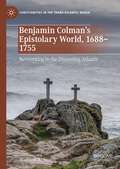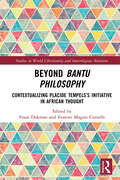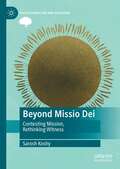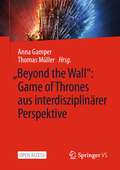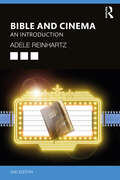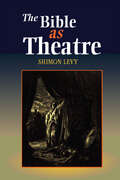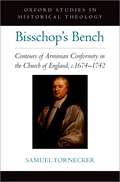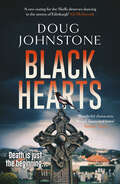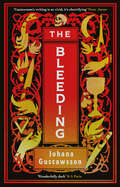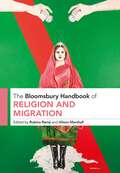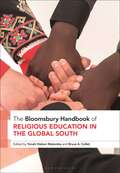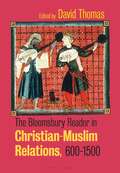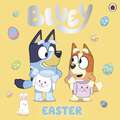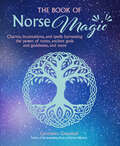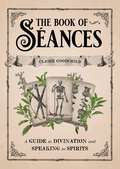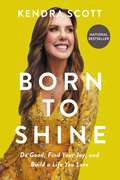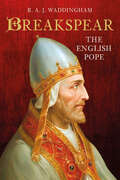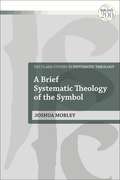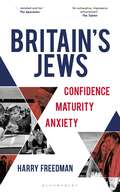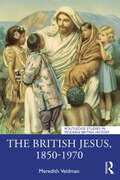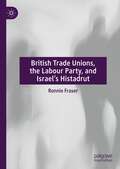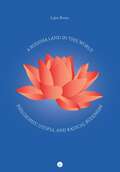- Table View
- List View
Benjamin Colman’s Epistolary World, 1688-1755: Networking in the Dissenting Atlantic (Christianities in the Trans-Atlantic World)
by William R. SmithThis book tells the story of the Rev. Benjamin Colman (1673-1747), one of eighteenth-century America’s most influential ministers, and his transatlantic social world of letters. Exploring his epistolary network reveals how imperial culture diffused through the British Atlantic and formed the Dissenting Interest in America, England, and Scotland. Traveling to and living in England between 1695-1699, Colman forged enduring connections with English Dissenters that would animate and define his ministry for nearly a half century. The chapters reassemble Colman’s epistolary web to illuminate the Dissenting Interest’s broad range of activities through the circulation of Dissenting histories, libraries, missionaries, revival news, and provincial defenses of religious liberty. This book argues that over the course of Colman’s life the Dissenting Interest integrated, extended, and ultimately detached, presenting the history of Protestant Dissent as fundamentally a transatlantic story shaped by the provincial edges of the British Empire.
Beyond Bantu Philosophy: Contextualizing Placide Tempels’s Initiative in African Thought (Studies in World Christianity and Interreligious Relations)
by Frans DokmanFranciscan priest Placide Tempels’s 1946 book, Bantu Philosophy, introduced a new discourse about African thought and beliefs, questioning the universality of Western philosophy and establishing paradigms that continue to dominate discussion of the relationships between Africa and the West today. More than 75 years after the publication of this influential text, this volume brings together a wide range of contributors to examine the legacy and impact of Tempels’s work for the study of African philosophy and religion. Reflecting on whether Bantu Philosophy reinforces conflict or convergence between Africa and the West, and its reception within Africa, scholars from both African and Western institutions provide new perspectives on both Tempels’s ideas and ongoing debates in African philosophy and religion.
Beyond Bantu Philosophy: Contextualizing Placide Tempels’s Initiative in African Thought (Studies in World Christianity and Interreligious Relations)
by Frans Dokman Evaristi Magoti CornelliFranciscan priest Placide Tempels’s 1946 book, Bantu Philosophy, introduced a new discourse about African thought and beliefs, questioning the universality of Western philosophy and establishing paradigms that continue to dominate discussion of the relationships between Africa and the West today. More than 75 years after the publication of this influential text, this volume brings together a wide range of contributors to examine the legacy and impact of Tempels’s work for the study of African philosophy and religion. Reflecting on whether Bantu Philosophy reinforces conflict or convergence between Africa and the West, and its reception within Africa, scholars from both African and Western institutions provide new perspectives on both Tempels’s ideas and ongoing debates in African philosophy and religion.
Beyond Missio Dei: Contesting Mission, Rethinking Witness (Postcolonialism and Religions)
by Sarosh KoshyIn this book, Sarosh Koshy strives to go beyond the mission model of Christianity that emerged alongside and within the colonial enterprise and ethos since the sixteenth century. Rather than denounce the inheritance of the mission movement that transformed both the church and world in innumerable ways, it is a simultaneous expression of appreciation for this precious heritage, and an attempt to do justice by it through a yearning quest for relevant paradigms of Christian engagement.Indeed, there is an intense tension within this book, and in fact a twin tension at that. The tension is between those seeking to keep the current mission paradigm alive out of habit or as a self-serving device, thus corrupting and withering away a bequeathal that essentially set free the voluntary/independent spirit of Christian individuals and their intentional collectives from both the ecclesiastical and political authorities. On the other side are those who enlist mission both as a subsequent activity and as a basis to pursue innocuous, and at times apparently heroic options that would seemingly satisfy a supposed missional mandatory. This work enlists postcolonial and poststructuralist resources pedagogically, to teach of mission, missiology, World Christianity, and intercultural theology.
„Beyond the Wall”: Game of Thrones aus interdisziplinärer Perspektive
by Anna Gamper Thomas MüllerDieses Open-Access-Buch beleuchtet das Serienphänomen „Game of Thrones“ aus unterschiedlichen wissenschaftlichen Perspektiven: Die rechtswissenschaftliche trifft auf die sprach-, musik-, literatur- und sozialwissenschaftliche, ferner die (kunst-)historische, psychologische und theologische Perspektive. Die Beiträge zeigen auf, dass die Serie reiche Anknüpfungspunkte für die wissenschaftliche Forschung unterschiedlichster Fachrichtungen bietet, die auch dazu anregen, sprichwörtlich „beyond the wall“ zu denken. Das Buch spricht dabei sowohl ein interdisziplinäres wissenschaftliches Publikum als auch sonstige Fans der Serie an.
Bible and Cinema: An Introduction
by Adele ReinhartzBible and Cinema: An Introduction is a comprehensive examination of how the Bible has been used and represented in mainstream cinema to develop its plots, characters, and themes. The book considers two general types of films: Bible movies that retell biblical stories, such as the Exodus and the life of Jesus, and Bible-related movies that make use of biblical books, stories, verses, and figures, and Bibles themselves to tell non-biblical, often fictional, narratives. Topics covered include: the contribution of Bible and Bible-related movies to the history of the Bible’s reception; the ways in which filmmakers make use of scripture to address and reflect their own time and place; the Bible as a vehicle through which films can address social and political issues, reflect human experiences and emotions, explore existential issues such as evil and death, and express themes such as destruction and redemption; the role of the Bible as a source of ethics and morality, and how this role is both perpetuated and undermined in a range of contemporary Hollywood films; and film as a medium for experiences of transcendence, and the role of the Bible in creating such experiences. This thoroughly updated second edition includes insightful analysis of films such as Noah, Gods and Men, Mary Magdalene, and The Shawshank Redemption, paying attention to visual and aural elements as well as plot, character, and dialogue. The book also includes pedagogical resources including discussions of film theory, as well as key words and discussion questions. Teachers, students, and anyone interested in the intersection of Bible and cinema will find this an invaluable guide to a growing field.
Bible and Cinema: An Introduction
by Adele ReinhartzBible and Cinema: An Introduction is a comprehensive examination of how the Bible has been used and represented in mainstream cinema to develop its plots, characters, and themes. The book considers two general types of films: Bible movies that retell biblical stories, such as the Exodus and the life of Jesus, and Bible-related movies that make use of biblical books, stories, verses, and figures, and Bibles themselves to tell non-biblical, often fictional, narratives. Topics covered include: the contribution of Bible and Bible-related movies to the history of the Bible’s reception; the ways in which filmmakers make use of scripture to address and reflect their own time and place; the Bible as a vehicle through which films can address social and political issues, reflect human experiences and emotions, explore existential issues such as evil and death, and express themes such as destruction and redemption; the role of the Bible as a source of ethics and morality, and how this role is both perpetuated and undermined in a range of contemporary Hollywood films; and film as a medium for experiences of transcendence, and the role of the Bible in creating such experiences. This thoroughly updated second edition includes insightful analysis of films such as Noah, Gods and Men, Mary Magdalene, and The Shawshank Redemption, paying attention to visual and aural elements as well as plot, character, and dialogue. The book also includes pedagogical resources including discussions of film theory, as well as key words and discussion questions. Teachers, students, and anyone interested in the intersection of Bible and cinema will find this an invaluable guide to a growing field.
The Bible as Theatre
by Shimon LevyA reading of the narrative portions of the Old Testament as dramatic texts.
Bisschop's Bench: Contours of Arminian Conformity in the Church of England, c.16741742 (OXFORD STU IN HISTORICAL THEOLOGY SERIES)
by Samuel D. ForneckerThe relationship between English conformity and the Arminian tradition has long defied neat explanation. In Bisschop's Bench, Samuel D. Fornecker charts the incompatible theological agendas into which post-Restoration Arminian conformity proliferated and challenges the thesis that a monolithic Arminianism marched steadily from the post-Restoration period into the early Hanoverian. Fornecker examines the theological life of the English Church by paying particular attention to the Arminian conformists who accentuated Reformed divinity in an unprecedented display of disambiguation from the Dutch Arminian tradition and those who exercised authority from the Bishops' bench. By demonstrating the scope of intra-Arminian divergence and the negatively defined consensus that united traditionalist clergy otherwise at odds over grace and predestination, Bisschop's Bench provides an illuminating perspective on the Arminian tradition in the political, confessional, and educative contexts of late seventeenth- and early eighteenth-century England.
Black Hearts (The Skelfs #4)
by Doug JohnstoneA faked death, an obsessive stalker, an old man claiming he’s being abused by the ghost of his late wife, and a devastating spectre from the past. The Skelfs are back in another explosive thriller, and this time things are more than personal…‘A new outing for the Skelfs deserves dancing in the streets of Edinburgh' Val McDermid‘Tense, funny and deeply moving’ Mark Billingham‘A total delight to be returned to the dark, funny, compulsive world of the Skelfs … Johnstone never fails to entertain whilst packing a serious emotional punch. Brilliant!’ Gytha Lodge________________________Death is just the beginning…The Skelf women live in the shadow of death every day, running the family funeral directors and private investigator business in Edinburgh. But now their own grief interwines with that of their clients, as they are left reeling by shocking past events.A fist-fight by an open grave leads Dorothy to investigate the possibility of a faked death, while a young woman’s obsession with Hannah threatens her relationship with Indy and puts them both in mortal danger. An elderly man claims he’s being abused by the ghost of his late wife, while ghosts of another kind come back to haunt Jenny from the grave … pushing her to breaking point.As the Skelfs struggle with increasingly unnerving cases and chilling danger lurks close to home, it becomes clear that grief, in all its forms, can be deadly…________________________‘The Skelfs keep getting better and better. Compelling and compassionate characters, with a dash of physics and philosophy thrown in’ Ambrose Parry‘Expertly written, with poise, insight and compassion’ Mary Paulson-Ellis’If you loved Iain Banks, you’ll devour the Skelfs series’ Erin Kelly‘Dynamic and poignant … Johnstone balances the cosmos, music, death and life, and wraps it all in a compelling mystery’ Marni Graff‘Just when you thought you couldn’t love the Skelfs more, Doug Johnstone finds a way to turn up the heat’ Live & DeadlyPraise for The Skelfs series***Shortlisted for the McIlvanney Prize for Best Scottish Crime Book of the Year******Longlisted for Theakston’s Old Peculier Crime Novel of the Year******Shortlisted for Amazon Publishing Capital Crime Thriller of the Year***‘An engrossing and beautifully written tale that bears all the Doug Johnstone hallmarks in its warmth and darkly comic undertones’ Herald Scotland‘Gripping and blackly humorous’ Observer‘A tense ride strong, believable characters’ Kerry Hudson, Big Issue‘The power of this book, though, lies in the warm personalities and dark humour of the Skelfs, and by the end readers will be just as interested in their relationships with each other as the mysteries they are trying to solve’ Scotsman‘Remarkable’ Sunday Times‘Keeps you hungry from page to page. A crime reader can’t ask anything more’ The Sun‘A thrilling, atmospheric book, set in the dark streets of Edinburgh. Move over Ian Rankin, Doug Johnstone is coming through!’ Kate Rhodes‘An unstoppable, thrilling, bullet train of a book that cleverly weaves in family and intrigue, and has real emotional impact. I totally loved it’ Helen Fields‘This enjoyable mystery is also a touching and often funny portrayal of grief ... more, please’ Guardian‘Wonderful characters: flawed, funny and brave’ Sunday Times‘Exceptional … a must for those seeking strong, authentic, intelligent female protagonists’ Publishers Weekly
The Bleeding: The dazzlingly dark gothic thriller that everyone is talking about…
by Johana GustawssonQueen of French Noir, Johana Gustawsson returns with a spell-binding, dazzlingly dark gothic thriller that swings from Belle Époque France to 21st-century Quebec, with an extraordinary mystery at its heart… FIRST in a bewitching new series‘Intriguingly dark and vivid, and so cleverly told through three different time frames’ Essie Fox‘A wonderfully dark, intricately woven historical thriller spanning three generations … it will have you hooked from the very first page’ B A Paris‘This novel is a whirlpool that draws you irresistibly into levels of darkness so much deeper than you can possibly be ready for’ Chris Brookmyre________________________________Three womenThree erasOne extraordinary mystery…1899, Belle Époque Paris. Lucienne’s two daughters are believed dead when her mansion burns to the ground, but she is certain that her girls are still alive and embarks on a journey into the depths of the spiritualist community to find them.1949, Post-War Québec. Teenager Lina’s father has died in the French Resistance, and as she struggles to fit in at school, her mother introduces her to an elderly woman at the asylum where she works, changing Lina’s life in the darkest way imaginable.2002, Quebec. A former schoolteacher is accused of brutally stabbing her husband – a famous university professor – to death. Detective Maxine Grant, who has recently lost her own husband and is parenting a teenager and a new baby single-handedly, takes on the investigation.Under enormous personal pressure, Maxine makes a series of macabre discoveries that link directly to historical cases involving black magic and murder, secret societies and spiritism … and women at breaking point, who will stop at nothing to protect the ones they love…_________________________________‘I found myself racing through the book, always wanting one more page, one more chapter. A wonderfully creepy, unsettling read, with a superb twist in its tail‘ James Oswald‘Gustawsson’s writing is so vivid, it’s electrifying. Utterly compelling’ Peter James‘I was hooked from the first page – a stunning and beautifully written gothic thriller full of atmosphere, intrigue and delight’ Alexandra Benedict‘What a brilliant, brilliant book … the last chapters knocked me sideways, and it’s a long time since that’s happened’ Lisa Hall‘Harrowing, compelling, haunting, vivid, twisty and shocking!’ Noelle Holten‘A powerful page-turner’ Livres Hebdo ‘Fluid, skilful, fearsome and breathtaking … the ending is horrifying’ La Marseillaise***NUMBER ONE BESTSELLER IN FRANCE***FOR FANS OF Laura Purcell, Elizabeth Macneal, Bridget Collins, Anna Mazzola, Ambrose Parry and Laura Shepherd-RobinsonPraise for Johana Gustawsson***Longlisted for the CWA International Dagger***‘A satisfying, full-fat mystery’ The Times‘Assured telling of a complex story’ Sunday Times ‘A real page-turner, I loved it’ Martina Cole‘Dark, oppressive and bloody, but it’s also thought-provoking, compelling and very moving’ Metro‘A bold and intelligent read’ Guardian‘Utterly compelling’ Woman’s Own‘Cleverly plotted, simply excellent’ Ragnar Jónasson‘A must-read’ Daily Express‘Bold and audacious’ R. J. Ellory‘Gritty, bone-chilling, and harrowing – it’s not for the faint of heart, and not to be missed’ Crime by the Book‘A relentless heart-stopping masterpiece' New York Journal of Books
The Bloomsbury Handbook of Religion and Migration (Bloomsbury Handbooks)
by Rubina Ramji and Alison MarshallThe Bloomsbury Handbook of Religion and Migration presents the story of religion and migration predominantly through the experiences of Muslims, Sikhs, Hindus and Buddhists, considering intersectional issues including race, ethnicity, class, gender and generation throughout. Many chapters are grounded in embodied ethnography including participant observation fieldwork, interviews, oral history collections and qualitative analysis, drawing on sociological and anthropological theory, as well as non-western and historical approaches to religion. Chapters also chronicle migration in regional, transnational, multicultural and populist contexts, examining everyday religiosity and religion across generations. The volume includes chapters on Islam and Muslim identity, Chinese and Vietnamese Buddhism, Filipino and Korean religiosity and Polish Catholicism.
The Bloomsbury Handbook of Religious Education in the Global South (Bloomsbury Handbooks)
by Yonah Hisbon Matemba and Bruce A. ColletThe Bloomsbury Handbook of Religious Education in the Global South presents new comparative perspectives on Religious Education (RE) across the Global South. Including 23 chapters written by scholars from the Global North and South, this is the first authoritative reference work on the subject. The handbook is thematically organised into seven sections. The first three sections deal with provision, response to changes in contemporary society, and decolonizing RE. The next four sections explore young people and RE, perspectives on teachers, RE in higher education, and finally, challenges and opportunities for RE. The term 'Global South' is used here primarily to signify the deep economic divide with the Global North, but the concept is also examined in historical, geographical, political, social and cultural terms, including the indelible influence of religion in all four broadly defined regions. Exploring RE from local, cross-national as well as regional and sub-regional perspectives, the handbook examines RE from its diverse past, present realities, and envisioned future revealing not only tensions, contestations, injustices and inequalities of power, but importantly, how inclusive forms of RE can help solve these problems.
The Bloomsbury Reader in Christian-Muslim Relations, 600-1500
by David ThomasThis Reader brings together nearly 80 extracts from the major works left by Christians and Muslims that reflect their reciprocal knowledge and attitudes. It spans the period from the early 7th century, when Islam originated, to 1500. The general introduction provides a historical and geographical summary of Christian-Muslim encounters in the period and a short account of the religious, intellectual and social circumstances in which encounters took place and works were written. Nearly all the translations are new, and a map is provided. Each of the six parts contains the following pedagogical features: -A short introduction -An introduction to each passage and author -Notes explaining terms that readers might not have previously encountered On the Christian side topics include: condemnations of the Qur'an as a fake and Mu?ammad as a fraud, depictions of Islam as a sign of the final judgement, and proofs that it was a Christian heresy. On the Muslim side they include: demonstrations of the Bible as corrupt, proofs that Christian doctrines were illogical, comments on the inferior status of Christians, and accounts of Christian and Muslim scholars in collaboration together.
Bluey: Easter (Bluey)
by BlueyCelebrate Easter with Bluey!It's Easter and Bingo is worried the Easter bunny has forgotten about her and Bluey like last year. But when they wake up to a series of clues, Bluey and Bingo are led on an exciting Easter egg treasure hunt around the house!Join Bluey and Bingo on this fun adventure around the Heelers' home.Want more Bluey? Also available:Bluey: Fun and Games Colouring BookBluey: Meet Bluey! Sticker Activity BookBluey: Bluey and Friends Sticker Activity Book
The Book of Norse Magic
by Cerridwen GreenleafDiscover the secrets of the Norse people and their magical practices to manifest an enchanted life. Embark on a sacred journey into the marvellous and mystical world of Norse magic, with Wiccan medieval scholar Cerridwen Greenleaf as your guide. Gain insight into the wonders of runes, including the art of divination, spells for protection and how to imbue treasured objects with your personal magic. Learn about Norse mythology, including the stories of the major gods and goddesses and how to call upon them for support and wisdom. Discover the basics of tree magic, such as the legend of Yggdrasil, the tree of life, and how to read omens in nature to avoid misfortune. With Cerridwen Greenleaf’s vast knowledge of medieval studies, The Book of Norse Magic is an eminently useful and inspirational handbook on harnessing this ancient power for modern life to bring wellness, calm, love, money and luck.
The Book of Séances: A Guide to Divination and Speaking to Spirits
by Claire GoodchildFrom an award-winning artist, a beautifully mysterious guide to conducting seances and communing with the spirits in our conscious and unconscious lives. As long as people have lived, they have longed for wisdom and comfort from those who have died. In The Book of Séances, artist, author, and witch Claire Goodchild takes readers on a journey through the historical landscape of spiritualism and guides questers through safe practices for cultivating a connection with the other side. The Book of Séances details the four types of spiritual encounters, teaches us how to protect ourselves, and breaks down the different tools -- from spirit boards and tarot to dominoes and charms -- that are essential for opening a bridge to the afterlife. Whether conducting solitary or group séances, this book offers a way to safely glimpse beyond the veil. Through her evocative writing and singular art, Claire provides a comprehensive history of the séance, alongside an immersive guide to accessing and communing with the spirit world. The Book of Séances provides hauntingly lovely signposts into our own personal mythology as revealed through our conscious and unconscious lives.
Born to Shine: Do Good, Find Your Joy, and Build a Life You Love
by Kendra ScottINSTANT NATIONAL BESTSELLERThis authentic and dynamic memoir from the CEO of Kendra Scott Jewelry delivers inspiration, leadership lessons, and spellbinding storytelling. For twenty years, Kendra Scott built her eponymous jewelry company from a hobby and an idea into a company worth more than a billion dollars, creating beautiful and affordable pieces with signature-cut natural gemstones packaged in a sunny yellow box. By any measure, she&’s the woman who has it all: a self-made billionaire, a generous philanthropist, and a mother of three with a squad of strong female friendships. Sounds pretty perfect, right? But perfection is a myth that doesn&’t serve any of us. A myth that encourages us to assume that we know what other people are going through, to judge each other on appearances and reputations, to present the best versions of ourselves and pretend like we&’ve got it all together even when everything is falling apart. Perfection isn&’t just a lie, it&’s exhausting, and Kendra is tired of it. In this vulnerable, wise, and laugh-out-loud book, Kendra takes us on a journey of personal stories and hard-earned life lessons, from her humble beginnings as an awkward, bullied young girl in small-town Wisconsin to launching a business in her spare bedroom with $500. With every pitfall, misstep, and failure, Kendra builds a life—and a career—rooted in joy, purpose, and doing good, a life she wants for every reader. With heart and humor, Kendra reminds us that not all that glitters is gold, and that there is no level of success that can insulate you from what it means to be a human being: that life is as messy as it is magical, that bad things happen to good people for no good reason, and that a good life does not mean a perfect one.
Breakspear: The English Pope
by R. A. WaddinghamIn over 2,000 years of Christianity, there has been only one pope from England: Nicholas Breakspear.Breakspear was elected pope in 1154, but his story started long before that. The son of a local churchman near St Albans, he would battle his way across Europe to defend and develop Christianity, facing war in Scandinavia and the Moors in the Iberian Peninsula. But it was after he took the throne of St Peter as Adrian IV that he would face his greatest threat: Frederick Barbarossa, who was determined to restore the Holy Roman Empire to its former greatness.In Breakspear: The English Pope, R.A.J. Waddingham opens the archives to tell the story of a man who rose from humble beginnings to glorious power – and yet has been all but forgotten ever since.
A Brief Systematic Theology of the Symbol (T&T Clark Studies in Systematic Theology)
by Joshua MobleyHow do Christians understand the Trinity? How does this understanding relate to other Christian teachings? In conversation with key thinkers in contemporary and classical theology, particularly Henri de Lubac, Karl Rahner, Thomas Aquinas and Augustine, this book argues that a theology of symbols can help us glimpse the mystery of the Trinity and see how this central Christian teaching corresponds to Christian understandings of creation, humanity and the church. A symbol is not here understood as an arbitrary sign, but as a sign that mediates the presence of the symbolized. Joshua Mobley examines the understanding of the Father as “symbolized” in the Son who is the “symbol” of the Father by the “symbolism” of the Spirit, the personal agent of unity between Father and Son. These trinitarian relations then structure creaturely relations to God: God is symbolized in creation, which is a symbol of God by participation in the Son, and the church is symbolism, the union of creation with God by the power of the Spirit. Mobley thus argues that a theology of symbol helps coordinate trinitarian theology with key themes in Christian dogmatics.
Britain's Jews: Confidence, Maturity, Anxiety
by Harry FreedmanAs a minority, Jews in Britain are confident, their institutions competent and mature. And yet within Jewish life in Britain there is a pervading sense of anxiety.Jews in Britain have done very well. They have risen to the top of nearly every profession, they run major companies, sit at the top tables in politics, make their voices heard in the media, are prominent in science and the arts. Of course there is serious poverty and gross disadvantage, just as there is in any community. But on any objective measure, British Jews have done well. Particularly when we consider where they came from, the impoverished, often oppressed lives that many Jews lived in Eastern Europe and the Ottoman Empire less than 200 years ago.Jews have lived in Britain longer than any other minority. They've been here so long, and are so ingrained into the national fabric, that they are often not considered to be a minority at all. Until a periodic outburst of antisemitism or a flare up in the Middle East, or both, turns the spotlight on them once again.British Jews have another distinction too. They have lived safely and securely, continuously, in Britain longer than any other modern Jewish community has lived anywhere else in the world. They have organised themselves in a way that serves as a model both to more recent immigrant communities in Britain and to Jewish communities elsewhere. Being British, they wear their distinctions lightly, they don't trumpet their achievements, in fact they rarely make a noise at all. But they give back quietly: established Jewish organisations help more recently arrived minorities to create their own structures, charities draw on the Jewish experience of dislocation and persecution to help oppressed people in the developing world, philanthropists support causes far beyond the boundaries of their own communities.Britain's Jews is a challenging look at Jewish life in the UK today. Based on conversations with Jews from all walks of life, it depicts, in ways that are at times disturbing, at other times inspiring, what it is like to be Jewish in 21st century Britain. And why Jewish life is still a subject of fascination.
The British Jesus, 1850-1970 (Routledge Studies in Modern British History)
by Meredith VeldmanThe British Jesus focuses on the Jesus of the religious culture dominant in Britain from the 1850s through the 1950s, the popular Christian culture shared by not only church, kirk, and chapel goers, but also the growing numbers of Britons who rarely or only episodically entered a house of worship. An essay in intellectual as well as cultural history, this book illumines the interplay between and among British New Testament scholarship, institutional Christianity, and the wider Protestant culture. The scholars who mapped and led the uniquely British quest for the historical Jesus in the first half of the twentieth century were active participants in efforts to replace the popular image of “Jesus in a white nightie” with a stronger figure, and so, they hoped, to preserve Britain’s Christian identity. They failed. By exploring that failure, and more broadly, by examining the relations and exchanges between popular, artistic, and scholarly portrayals of Jesus, this book highlights the continuity and the conservatism of Britain’s popular Christianity through a century of religious and cultural transformation. Exploring depictions of Jesus from over more than one hundred years, this book is a crucial resource for scholars of British Christianity in the nineteenth and twentieth centuries.
The British Jesus, 1850-1970 (Routledge Studies in Modern British History)
by Meredith VeldmanThe British Jesus focuses on the Jesus of the religious culture dominant in Britain from the 1850s through the 1950s, the popular Christian culture shared by not only church, kirk, and chapel goers, but also the growing numbers of Britons who rarely or only episodically entered a house of worship. An essay in intellectual as well as cultural history, this book illumines the interplay between and among British New Testament scholarship, institutional Christianity, and the wider Protestant culture. The scholars who mapped and led the uniquely British quest for the historical Jesus in the first half of the twentieth century were active participants in efforts to replace the popular image of “Jesus in a white nightie” with a stronger figure, and so, they hoped, to preserve Britain’s Christian identity. They failed. By exploring that failure, and more broadly, by examining the relations and exchanges between popular, artistic, and scholarly portrayals of Jesus, this book highlights the continuity and the conservatism of Britain’s popular Christianity through a century of religious and cultural transformation. Exploring depictions of Jesus from over more than one hundred years, this book is a crucial resource for scholars of British Christianity in the nineteenth and twentieth centuries.
British Trade Unions, the Labour Party, and Israel’s Histadrut
by Ronnie FraserThis book explores the British Labour Party and the trade unions and how their relationship with the Jews of Palestine and Israel has evolved over the past one hundred years. It also reflects the changing attitudes of the Labour Party and the unions towards the persecution of the Jews, a Jewish homeland in Palestine, Israel and antisemitism. An in-depth examination of critical events in European and Middle East history reveals the links between British unions and their Israeli union counterpart, the Histadrut (General Federation of Labour), and sets out the circumstances in which the unions went from backing the Labour Party’s 1917 war aims declaration, which called for the establishment of a Jewish homeland in Palestine, through to the present day, which sees the unions promoting campaigns for boycotts and sanctions against the State of Israel.
A Buddha Land in This World: Philosophy, Utopia, and Radical Buddhism
by Lajos BronsIn the early twentieth century, Uchiyama Gudō, Seno’o Girō, Lin Qiuwu, and others advocated a Buddhism that was radical in two respects. Firstly, they adopted a more or less naturalist stance with respect to Buddhist doctrine and related matters, rejecting karma or other supernatural beliefs. And secondly, they held political and economic views that were radically anti-hegemonic, anti-capitalist, and revolutionary. Taking the idea of such a “radical Buddhism” seriously, A Buddha Land in This World: Philosophy, Utopia, and Radical Buddhism asks whether it is possible to develop a philosophy that is simultaneously naturalist, anti-capitalist, Buddhist, and consistent. Rather than a study of radical Buddhism, then, this book is an attempt to radicalize it. The foundations of this “radicalized radical Buddhism” are provided by a realist interpretation of Yogācāra, elucidated and elaborated with some help from thinkers in the broader Tiantai/Tendai tradition and American philosophers Donald Davidson and W.V.O. Quine. A key implication of this foundation is that only this world and only this life are real, from which it follows that if Buddhism aims to alleviate suffering, it has to do so in this world and in this life. Twentieth-century radical Buddhists (as well as some engaged Buddhists) came to a similar conclusion, often expressed in their aim to realize “a Buddha land in this world.” Building on this foundation, but also on Mahāyāna moral philosophy, this book argues for an ethics and social philosophy based on a definition of evil as that what is or should be expected to cause death or suffering. On that ground, capitalism should be rejected indeed, but utopianism must be treated with caution as well, which raises questions about what it means – from a radicalized radical Buddhist perspective – to aim for a Buddha land in this world.
